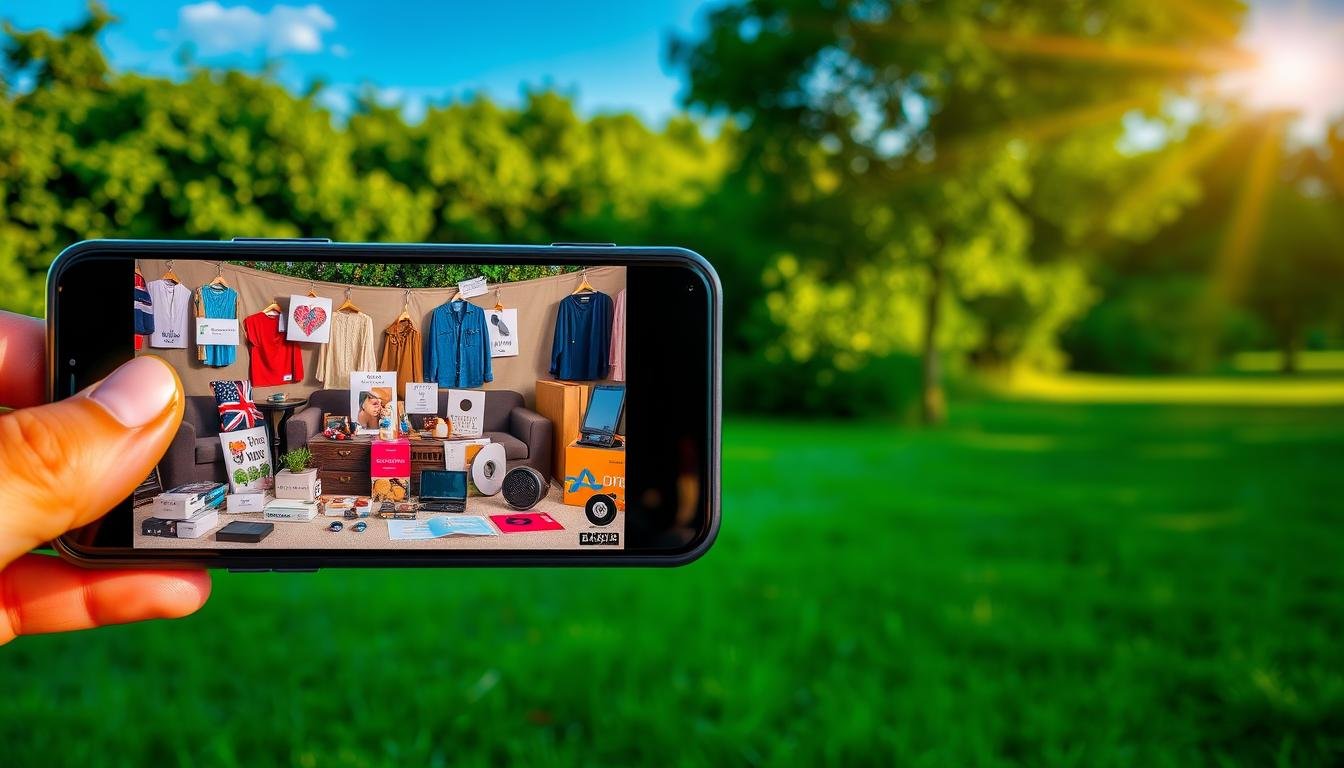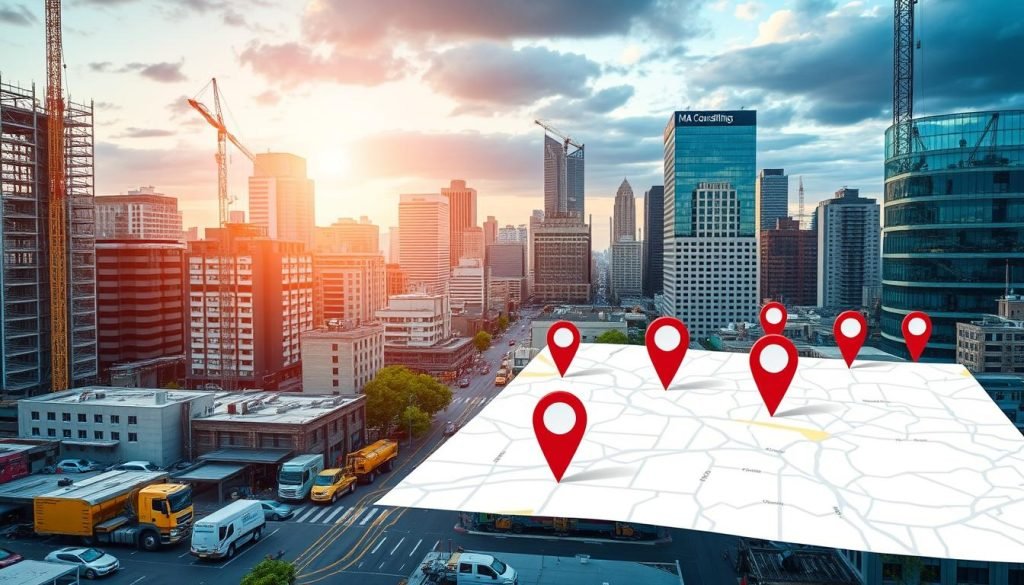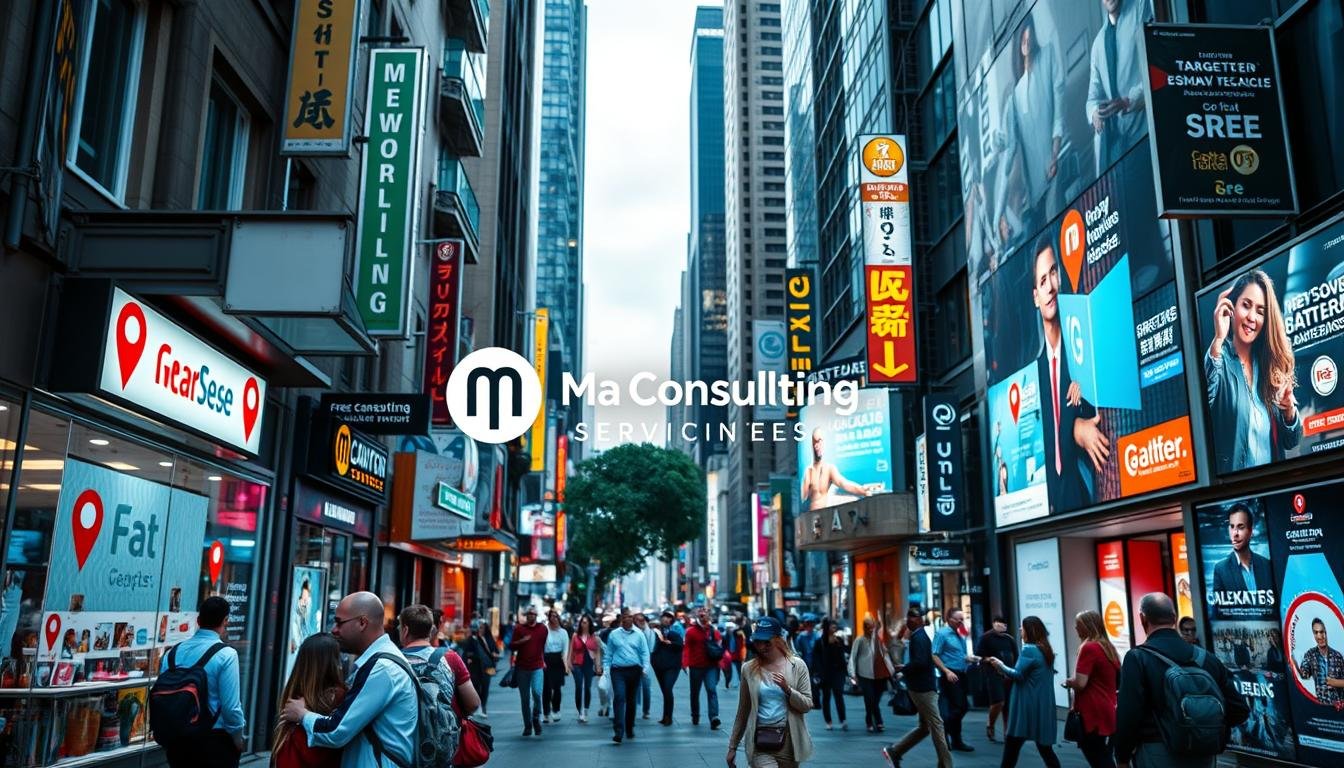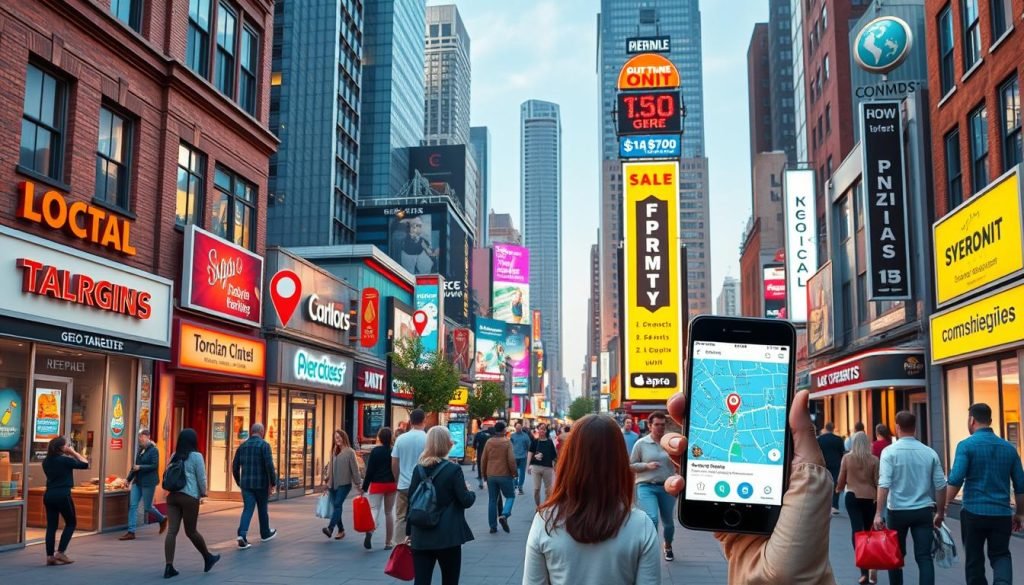Did you know that using geo-targeting can boost engagement rates? It makes content more personal to users’ locations. Geo-tagging your product photos makes your content more relevant to your audience. This helps people find you when they search locally.
Geo-tagging adds exact coordinates to an image. It shows where the photo was taken. This tool helps businesses market local products and services. It also promotes physical stores and attracts online users.
Ma Consulting Services knows how key geo-tagged photos are. They help boost your online presence and connect with your audience. By using location-based photography and geotagging ecommerce images, you can reach local markets. This improves your brand’s authenticity and drives sales.
Key Takeaways
- Geo-tagging enhances local SEO, making it easier for businesses to appear in relevant local searches.
- Businesses utilizing geo-targeting can see improved engagement rates due to personalized content tailored to users’ locations.
- Geo-tagged social media posts help tap into local markets, enriching brand presence among specific geographical audiences.
- Geo-tagging can help businesses avoid wasted advertising spend by focusing on local audiences genuinely interested in their offerings.
- Ma Consulting Services offers expert guidance on geo-tagging and customized photography solutions to optimize your online presence.
The Importance of Geo-Tagged Product Photos
In today’s digital world, using geo-tagged photos for your products is key to good online marketing. Adding spatial data and geographic metadata to your images boosts your online presence. It also improves customer interaction and makes your brand seem more real.
Boosting Online Visibility
Geotagging your product photos can really help with local SEO. By adding geo-tags to your site and photos, you’re more likely to show up in local searches. This targeted approach helps your marketing reach the right people in the right places.
Research shows that using geo-tagging can increase website traffic. People searching for local stuff are more likely to click on your site. Plus, making your content location-specific can lead to more sales, as targeted leads are more likely to buy.
Improving Customer Engagement
Geo-tagged product photos not only draw in new customers but also strengthen your bond with current ones. User-generated content with geo-tags feels like a personal recommendation. This can be more effective than regular ads. Encouraging customers to share their experiences with your products can build a sense of community and trust around your brand.
Also, geo-tagging your images on social media platforms like Instagram and Facebook helps you connect with local audiences. This drives traffic and engagement from people near your business. Regularly updating your social media with fresh, geo-tagged content keeps your local SEO strong and keeps your audience interested.
Enhancing Brand Authenticity
Using geo-tagged product photos in your marketing can also make your brand seem more authentic. Showing your products in real-world settings adds context and shows how they work in everyday life. This makes your brand more relatable and trustworthy to customers.
Geo-tagged visuals are also great for storytelling. By highlighting the unique aspects of different locations and how your products fit into them, you create compelling stories. This authentic marketing approach can set your brand apart from competitors and build a loyal customer base.
At Ma Consulting Services, we know how important geo-tagged product photos are for your online presence. Our team is skilled in spatial data embedding, geographic metadata for visuals, and geospatial product cataloging. We ensure your marketing efforts are optimized for the best results. Contact us today to learn how we can help you use geo-tagged visuals to elevate your brand.
How to Capture Excellent Geo-Tagged Product Photos
Getting high-quality, GPS-infused product shots is key for businesses wanting to boost their online presence. Using location-aware product imagery in your marketing can make your products look great and real. Here are some steps to make excellent geo-tagged product photos:
Choosing the Right Location
When picking a spot for your photoshoot, think about a few things:
- Is it relevant to your product or brand?
- Does it look good?
- Is it easy to get to and safe?
- What’s the lighting like, and what time of day is it?
Choosing a location that fits your products and brand well helps create visuals that connect with your audience.
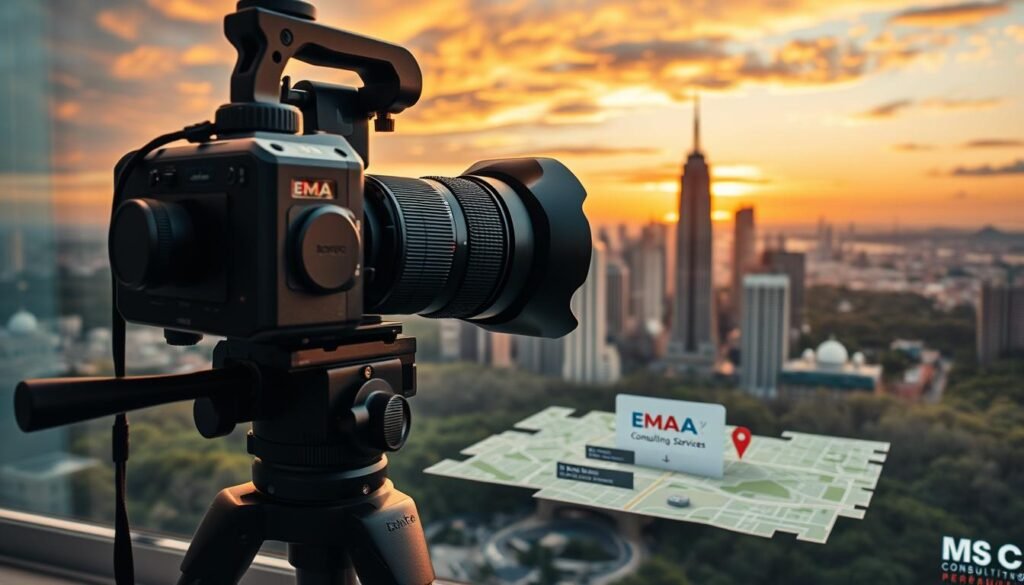
Tips for Effective Photography
To get amazing geo-tagged product photos, remember these tips:
- Make sure your phone or camera’s GPS is on.
- Use natural light whenever you can.
- Try different angles and views.
- Focus on how your product looks in the frame.
- Show your products in use or with something else.
By following these tips, you can make product images that show off your brand and grab people’s attention.
Utilizing GPS Technology
Today’s smartphones and cameras have GPS, making it easy to take geo-tagged photos. Make sure your device’s GPS is on while taking photos. This adds location data like date, time, and exact spot to the photo’s EXIF metadata.
If your device lacks GPS or you need to add location to photos, use geotagging tools or apps. These let you enter coordinates or pick a spot on a map. This way, all your product photos will be geo-tagged for better impact.
Using GPS and geo-mapping makes your product photos more than just pictures. They show where your products are and add value. This makes your visuals more real and engaging, helping your online presence and customer interest.
Best Practices for Implementing Geo-Tagged Photos
To get the most out of geo-tagged product photos, follow some key steps. Organize your photos, link them to social media, and check how they do. This way, you can show off your products well and draw in new customers.
Organizing Your Photo Library
It’s important to keep your geo-tagged photos tidy. Here are some tips:
- Give each photo a clear title and caption with keywords about your business
- Sort your photos by type, location, or campaign
- Keep your photos up to date with new products or events
Integrating with Social Media Platforms
Using social media can make your photos more seen and shared. Here’s how to do it:
- Post your photos on Google My Business under the right category
- Share them on Instagram, Facebook, and Twitter
- Ask customers to tag your business in their photos
Analyzing Performance Metrics
It’s key to check how your photos affect your online presence and customer interest. Look at these stats:
| Metric | Impact |
|---|---|
| Local Search Visibility | Geo-tagging can boost local search visibility by up to 50%, drawing in more local customers. |
| Click-Through Rates (CTRs) | Using geo-tagged images can raise CTRs for local searches by 30%. |
| Organic Traffic | Geo-tagged content can increase organic traffic by 20%, making it more appealing to locals. |
| Competitive Advantage | Companies that use geo-tagging well can rank up to 25% higher in local searches than those who don’t. |
Use tools like Google Analytics and SEMrush to track these metrics. This will help you see how your geo-tagged photos are doing and improve your strategy based on real data.
How Ma Consulting Services Can Help
Ma Consulting Services helps businesses use geographic metadata for visuals. This boosts their online presence and attracts local customers. Our team guides on geospatial product cataloging and geo-tagging strategies.
By adding GPS-infused product shots, you can see more visibility and engagement. This makes your marketing efforts more authentic.
With more devices tracking locations, staying ahead is key. Ma Consulting Services offers customized photography solutions. We use advanced tech like RFID and satellite imagery to help you save costs and make smart decisions.
The global GIS market is growing fast, expected to hit US$13.6 billion by 2027. Investing in geospatial capabilities is now more important than ever. Ma Consulting Services keeps up with trends and best practices. Contact us at +1 (951) 271-8256 or visit our website to boost your e-commerce with geo-tagged photos.
Expert Guidance on Geo-Tagging
Our team at Ma Consulting Services knows a lot about geo-tagging. We help you capture, organize, and use geotagged photos for your business. This way, you can create engaging product presentations that connect with your audience.
Customized Photography Solutions
Every business has different needs for product photography. That’s why Ma Consulting Services offers customized solutions. We help with location choices, photography techniques, and GPS technology. We also guide on organizing your photo library and analyzing performance.
Contact Us for Assistance
Ready to improve your product photography with geo-tagging? Ma Consulting Services is here to help. Our team is dedicated to your success in e-commerce. Contact us at +1 (951) 271-8256 or visit our website for a consultation and learn how we can enhance your geospatial product cataloging and GPS-infused product shots.
FAQ
What is geo-tagging, and how does it work with product photos?
Geo-tagging adds the exact location to an image. It includes longitude and latitude. This info is in the image’s EXIF data, which shows when and where it was taken.
By geo-tagging product photos, businesses can show where they and their customers are. This helps market local products and services better.
Why are geo-tagged product photos important for online visibility?
Geo-tagging your website and product photos helps you show up in local searches. It boosts your local SEO. This way, your marketing reaches the right people in the right place.
How can geo-tagged product photos improve customer engagement?
Geo-tagged photos act like personal recommendations. They can be more effective than ads. By using geo-tagged photos, you can attract more online users and encourage them to visit your store or make a purchase.
What should I consider when choosing a location for my geo-tagged product photos?
Pick a location that fits your business and products. Choose a spot that looks good and appeals to your audience. Make sure it’s well-lit and shows off your products well.
How can I utilize GPS technology to capture geo-tagged product photos?
Modern phones and cameras use GPS to record the photo’s location. Turn on your device’s GPS when taking photos. Or, use a geotagging tool or app to add location data to photos.
What are some tips for organizing my geo-tagged product photo library?
Use a clear naming system for your photos. Include keywords related to your business. Organize by location, product, or campaign for easy access.
How can I integrate geo-tagged product photos with social media platforms?
Platforms like Instagram and Facebook support geo-tagging. Add location info when uploading photos. This makes them findable for local searches. Encourage customers to tag your business in their photos too.
What performance metrics should I analyze for my geo-tagged product photos?
Track views, engagement, click-through rates, and conversions. See how many find your business through these photos. Use this data to improve your geo-tagging and photography.
How can Ma Consulting Services assist with geo-tagging product photos?
Ma Consulting Services helps businesses use geo-tagged photos to attract local customers. Our experts guide you on effective geo-tagging and offer customized photography solutions.
Source Links
- https://devrix.com/tutorial/geo-targeting-usage/
- https://www.hummingbirds.com/blog/how-to-create-a-geo-tag-on-instagram
- https://www.linkedin.com/pulse/geo-tagging-images-maximum-impact-your-google-business-mamun-dmpgc
- https://localmarketinginstitute.com/geotag-photos/
- https://thatware.co/image-geotagging/
- https://techwishes.com/blog/how-geo-tagging-images-supercharge-seo
- https://digital-photography-school.com/how-to-geo-tag-your-photographs-with-google-maps/
- https://img.courses/blog/how-to-geotag-photos-for-google-my-business/
- https://investinhamilton.ca/hamilton-business-centre/2020/04/07/google-my-business-photo-optimization/
- https://quickcreator.io/seo/mastering-local-seo-rankings-geotag-images-ultimate-guide/
- https://two44software.com/exclusive-services/the-ultimate-guide-to-geo-tagging-images-boost-your-seo-and-engagement
- https://www.esri.com/about/newsroom/arcwatch/add-geotagged-photos-to-arcgis-online-web-maps/
- https://www2.deloitte.com/us/en/insights/focus/signals-for-strategists/geospatial-analytics-use-cases.html

